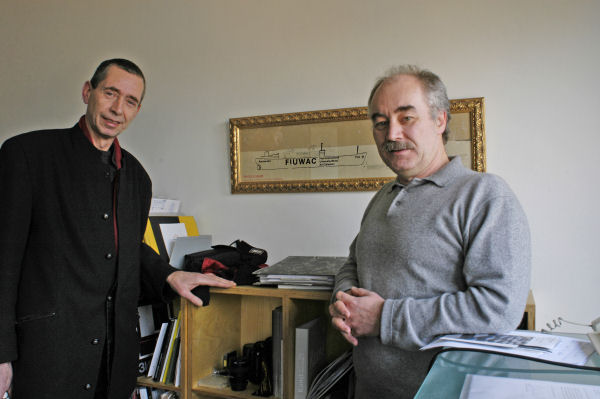|
 Foreword Foreword
by Prof. Dr. Ferdinand Ullrich, Director Kunsthalle Recklinghausen, Germany
Waldo Bien’s work is inter-disciplinary. The principles of art, surface, space, color, figuration, are simultaneously societal, in the sense which his teacher, to whom he is indebted, Joseph Beuys, meant by ‘social sculpture’. Mythology and science is understood by Bien as equally enabling for the unity of a complete life philosophy. His ‘color theory’ displays a theory of nature and society within which the laws of motion of the world are manifested.
Bien’s work transcends categories. Sculpture, drawing, photography, and installation all play equivalent roles. His work releases a continuing intellectual stream and process of development, withdrawing from the current market mechanisms. The impressions and experiences that he deals with could come as much from a German mine as from an encounter with Pygmies in Africa.
Waldo Bien is interested in the energies and resources of this world and its past. His large-scale photos contain whale oil, preserved between the plates of the picture. It is the elixir of life, the symbolf force from which a living essence can be released.
The transformation of energy, its preservation and use is left over in the history of the earth, can be construed as the principle of Waldo Bien’s artistic work. Thus the significance of coal which we see in his work as a bearer of color and a sculptural element, is at the same time an energy source from the very history of the earth, like a spiritual energy, which derives from a once living primeval forest.
Bien engages himself with the earliest cultures and travels to the furthest places in the world. Thus he opens the present and the future as much as the civilisation of Western Europe. What is strange, or, far away is to him the closest. His way of viewing the world is through metamorphosis and evolution. Thus for him all that lies between the poles is more important than the poles themselves. This ‘no-man’s-land’ seems to him largely unexplored and therefore for him an important source of inspiration. He approaches the world in a particular and very personal way. Thereby works come into being which shift between compulsion and openess for the viewer. The material which he uses is not only sculptural but also spiritual, a source of diverse energies and associations. Bien undertakes a quasi-ethnographic research on civilisation, in areas between history, ecology, geography and ethnology. His chef d’œuvre the so called death-room (Death Room Interior), is made up from coal pieces taken from the Prince Leopold mine in Wulfen, in the region of the Rhein and Ruhr. Simultaneously in this work he creases over time and space. Once again the role of metamorphosis plays an important role, creation, death, resurrection.
In the singular Bien shows the whole, in the body the spirit, in the inner the outer, in the surface the depth, in art, life. In the end this conception even goes beyond his own artistic personality. Works have come into being through co-operation with other artists, who have been neither overwhelmed, nor diminished. In the common sharing the individual is affirmed. The ‘Waldo Bien Archive’ is also a broad life-long project. On one hand, the art works are anchored and described in an historical sense, and, on the other, placed in a highly mobile situation. The archive is also a living store-house of memory, which can be freely released. Finally the initiative of the Free International University, and the formation of the World Art Collection are further building blocks in the life and art world of Waldo Bien.
Our thanks to Waldo Bien with whom we have for many years discussed a shared project. He has worked tirelessly on the organisation, editing, translating, and the building of the exhibition, and not least on sourcing funding.
Patrick Healy has undertaken the enormous task of analysing Bien’s extensive work in a detail previously unknown, and showing its art historical and philosophical interrelations. To him a special thanks.
Thanks are due to these who have supported this project and enabled the apperance of an extensive publication: Ministerium für Arbeit, Soziales und Stadtentwicklung, Kultur und Sport des Landes Nordrhein-Westfalen, Düsseldorf; VSB Fonds, Utrecht; Prins Bernhard Cultuurfonds, Amsterdam; Mandriaan Stichting, Amsterdam; VEW Energie AG, Dortmund; Triodos Bank, Zeist; Free International University, Amsterdam.
Foreword - 1 - 2 - 3 Next Page >
|